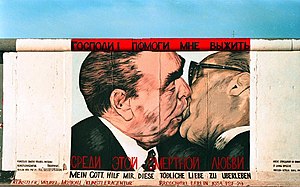My God, help me survive this deadly love

|
| My God, help me survive this deadly love |
|---|
| Dmitri Vladimirovich Vrubel , 1990 |
|
Graffiti , 365 cm × 480 cm |
|
East Side Gallery ; Friedrichshain , East Berlin , German Democratic Republic |
My God, help me this deadly love to survive ( Russian Господи! Помоги мне выжить среди этой смертной любви Gospodi! Pomogi mne vyschit sredi etoi smertnoi ljubwi ), sometimes called the fraternal kiss or Bruderkuss painting called, is a graffito of Dmitri Vrubel and part the East Side Gallery in Berlin . It is one of the well-known paintings on the Berlin Wall . The work of art created in 1990 shows Leonid Brezhnev and Erich Honecker kissing their brother and is a reproduction of a photograph from 1979, taken during the celebrations for the 30th anniversary of the founding of the GDR .
The photography
The photograph of the famous hug was taken by Régis Bossu on October 7, 1979 in East Berlin and has been published many times. Brezhnev was on a visit to the GDR to celebrate the thirtieth anniversary of his communist nation . On October 5th, the GDR and the Soviet Union signed a ten-year mutual support agreement. After that, the GDR would supply ships, machinery and chemicals, the Soviet Union would supply the country with oil and nuclear materials. This treaty was sealed again by the meeting of politicians and the kiss.
Press photographer Bossu photographed the kiss on the mouth after Leonid Brezhnev had finished his speech on the 30th anniversary of the GDR: Brezhnev took off his glasses, stretched out his arms and pursed his lips. He and Honecker then tilted their heads a little to one side, the skin of the neck wrinkling over Brezhnev's collar. Tenderly intertwined, the two gray and wrinkled men pressed their lips together and kept their eyes tightly closed in order to surrender to the moment. The photo was later sent to editorial offices by the French photo agency under the name "Le Baiser", the kiss.
The rights to the photography are currently with Corbis .
The paintings
Eleven years after it was published, the legendary Bossus kiss photo became a symbol of his private love affair for the Moscow painter Dmitri Vrubel: because he had to choose between two women at the time, he subtitled his wall artwork: “My God, help me, this deadly love to survive ”after he painted the picture as graffito on the Berlin Wall in spring 1990, shortly after the fall of the Berlin Wall and a few months before German reunification . Honecker's skin color looked green on the wall painting and Brezhnev's complexion was baby pink. Along with other works in this section, the painting was preserved as part of the East Side Gallery after the fall of the Berlin Wall. This 1.3 kilometer long section of the wall, painted by 118 artists from 21 countries, was so badly damaged over the years by vandalism and weathering that the gallery was finally completely renovated in 2009. To do this, the paintings were completely removed from March 2009 and the original artists were asked to paint them again, this time with more permanent colors. Wrubel accepted the order and donated the tendered 3,000 euros to a social art project in Marzahn .
The photographer Bossu and Wrubel met in 2009 and had their picture taken on June 16 in front of the completely restored work.
Of the 106 paintings in the East Side Gallery , the Brother's Kiss is the most famous. It achieved cult status and can be sent as a postcard, worn on t-shirts and printed on mini dresses.
Critical evaluation of the painting
My God, help me to survive this deadly love has become a well-known graffiti work on the Berlin Wall. Anthony Read and David Fisher describe the painting as "extraordinarily blatant, with sharp satirical nuances".
Adaptations (selection)
- Make Everything Great Again : Mural in Vilnius with a brotherly kiss from Russian President Putin and Donald Trump , modification of the election campaign - slogans " Make America Great Again "
Web links
Individual evidence
- ↑ a b photo and information . Corbis . Retrieved October 8, 2015.
- ↑ a b c Jochen Clemens: The longest open-air gallery in the world. The story of a painting: the brotherly kiss . In: Die Welt , November 22, 2009
- ^ John Vinocur: Brezhnev Arrives in East Germany For 30th Anniversary Celebration; Ceausescu Is Not Expected (English) . In: The New York Times , October 5, 1979, p. A8.
- ^ John Vinocur: Soviet and East Germans Sign an Economic Pact (English) . In: The New York Times , October 6, 1979, p. 30.
- ↑ a b c Carolin Pirich: brother kiss. One picture of one picture. FAZ , August 13, 2009.
- ↑ a b Malte Göbel: East Side Gallery Berlin: No more brother kiss . In: Spiegel Online . March 27, 2009. Retrieved October 8, 2015.
- ^ Nicolas Schmitt: Opening of the East Side Gallery: Brother kiss in old freshness . In: Spiegel Online . November 5, 2009. Retrieved October 8, 2015.
- ↑ Tobias Schwarz: Russian artist Dmitry Vrubel and photographer Regis Bossu pose before restoration work on a segment of the East Side Gallery (English) , 2space. June 16, 2009.
- ↑ Patrick Major: Behind the Berlin Wall: East Germany and the frontiers of power (English) . Oxford University Press, Oxford / New York 2009, ISBN 978-0-19-924328-0 , p. 276.
- ↑ John Tagliabue: What divides Berlin now? (English) . In: The New York Times Magazine , April 7, 1991.
- ↑ Anthony Read, Fisher, David: Berlin: the biography of a city (English) . Hutchinson, London 1994, ISBN 978-0-09-178021-0 , p. 308.
Coordinates: 52 ° 30 ′ 14 " N , 13 ° 26 ′ 34.1" E
